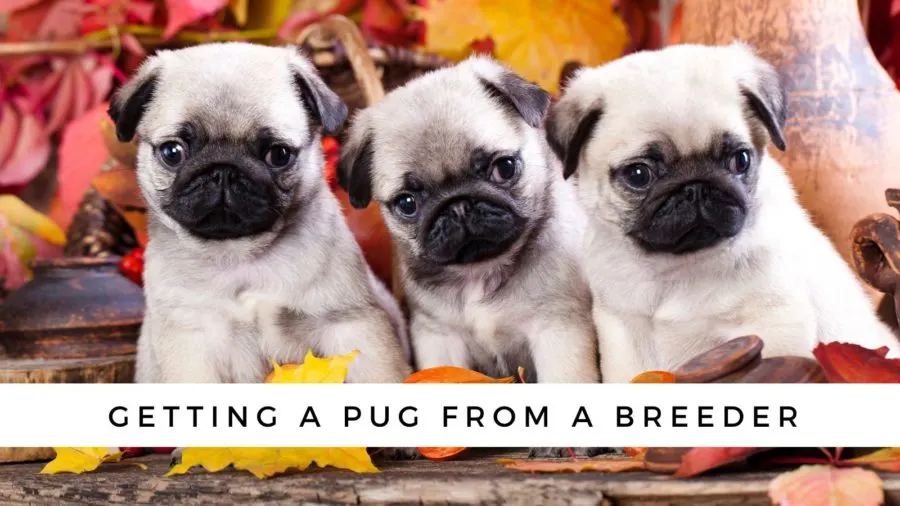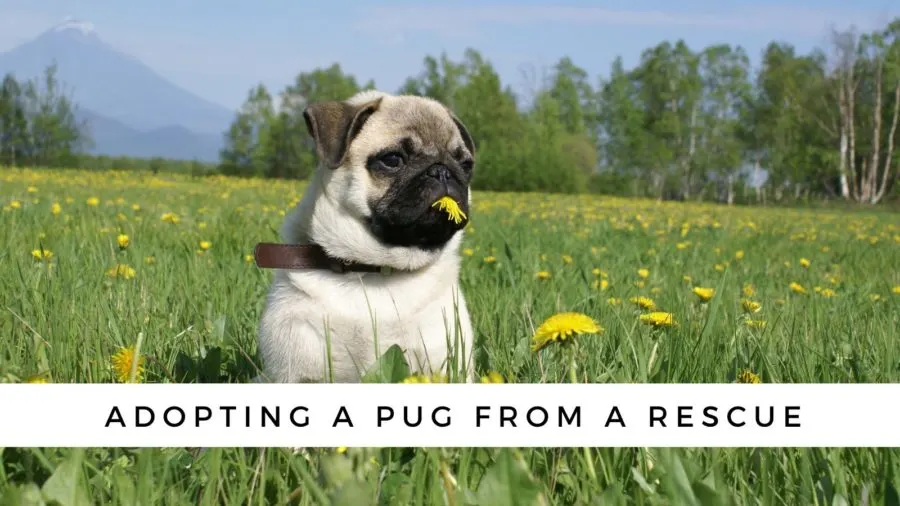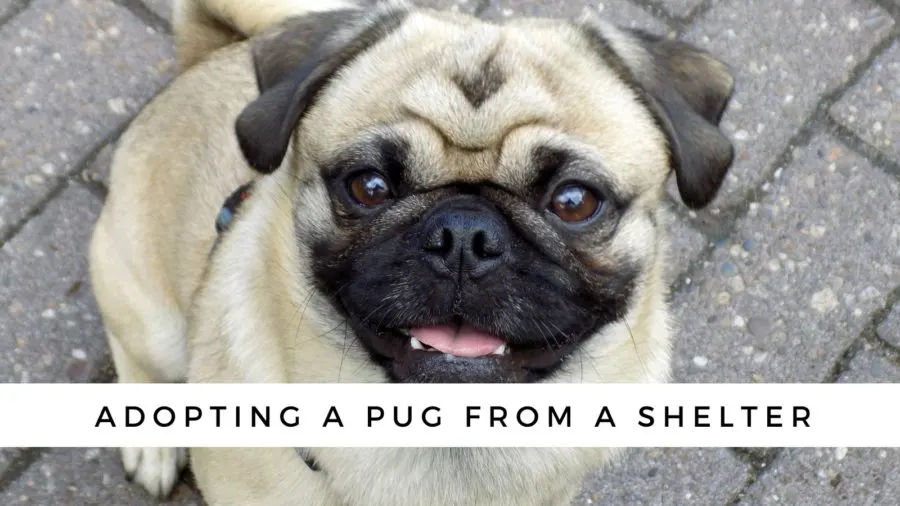There’s no denying the sheer cuteness of a Pug (and especially a Pug puppy!) If you have decided a Pug is the right fit for your lifestyle and you are now investigating adding a Pug to your family, you are probably also wondering about the Pug dog price tag. Like many popular purebred dogs, the price of a Pug varies with many factors. Below we’ll take a look at the price for puppies and adults from a variety of sources—and what you need to know before you make a decision.

Why are Pugs so expensive?
Before we examine the prices of different Pug colors and genders, let’s look at the elephant in the room: Pugs are expensive.
While the Pug dog price is lower than some other breeds such as the French Bulldog (which can easily cost $3,000, $10,000…or more), the Pug price tag is a hefty one when compared to breeds such as the Australian Shepherd.
So just why are Pugs so expensive? One reason is because Pugs, like most other Brachycephalic dogs (with flat faces and large heads), are most often born via cesarean section. Due to the Pug’s large head and shoulders, mothers generally require a C-section—which means added expense for delivery as well as recovery for the mother.
Pugs are also susceptible to numerous orthopedic and hereditary diseases—so reputable breeders will conduct testing on both parents to help ensure a healthy litter.
These tests include:
- The Orthopedic Foundation for Animals (OFA) evaluation. This test screens for Hip Dysplasia and Patellar Luxation. Breeders also have the option to test for Elbow Dysplasia with this screening.
- The ACVO Eye Exam by an ACVO Ophthalmologist. This test is looking for Dry Eye, Dystichia (caused by extra eyelashes), Entropion (when the lid rolls in and rubs the eye lashes against the eye), and Proptosis, a risk due to the Pug’s bulging eyes.
- DNA test from the UC Davis Veterinary Genetics Lab. This important test screens for Necrotizing meningoencephalitis (NME), a fatal brain disorder that can kill Pug puppies. This doesn’t test if the parents have NME or not; the test is screening for the risk of NME that the parents could pass along to puppies.
- DNA-based PKD test which screens for Pyruvate Kinase Deficiency (PKD). This metabolic disease breaks down the red blood cells of a young Pug.
In addition to the above tests on the parents, it’s also recommended to run a Serum Bile Acid Test on puppies once they reach 9 or 10 weeks of age.
Also, a breeder needs to ensure that Pug puppies don’t have signs of brachycephalic obstructive airway syndrome—and that the parents did not have this (either currently or in the past with surgical correction.)
All that testing adds up so it’s easy to see why Pugs are more expensive than some other dog breeds!
If you’ve adopted a Pug and would like some of these tests, you can run the Embark Dog DNA Test using a simple saliva test you can perform at home. It tests for over 215 genetic diseases and conditions–including Degenerative Myelopathy, Pyruvate Kinase Deficiency (PKLR Exon 7, Pug Variant), May-Hegglin Anomaly (MYH9), all possibilities with Pugs.
What’s the Price of a Pug at a Breeder?

The price of a Pug at a breeder generally ranges from $1000-$3000.
The price will depend on several factors:
- The location of the breeder. The rules of supply and demand pertain to dogs as well so larger metropolitan areas are often more expensive.
- The pedigree of the parent Pugs. Pugs that have participated in sanctioned competitions have more expensive litters.
- Whether the Pug is a show quality dog or a pet quality dog. Most breeders will require that pet quality dogs be spayed/neutered at the appropriate age. Show quality puppies with a future in competitive dog shows and breeding are more expensive.
- The age of the Pug. Puppies are definitely more expensive; you may occasionally find a breeder selling a retired breeding Pug or a Pug that originated at the breeder but has been returned.
- The color of the Pug. AKC recognized two colors: black and fawn. The Canadian Kennel Club recognizes fawn, silver fawn and black. The Federation Cynologique Internationale and the Kennel Club of the UK both recognize silver (sometimes called silver-fawn), apricot (often called apricot-fawn), fawn and black. Along with these colors, you’ll often see mentions of Brindle Pugs. The less common the color, the more expensive the dog.
When adopting from a breeder, it’s especially important to make sure you are adopting from a reputable breeder—not a backyard breeder and not an online seller.
How to Locate a Reputable Pug Breeder
- Check the Breeder Directory at the Pug Dog Club of America.
- Attend a sanctioned dog show and talk with Pug breeders and competitors for recommendations.
- Ask your veterinarian for recommendations regarding reputable breeders.
- Do an online search for complaints. Do a search for “BREEDER NAME complaints” or “BREEDER NAME scam” to see if you find complaints. Are there Better Business Bureau (BBB) complaints? Check the Facebook page of the breeder and read through comments. (Remember, however, comments can be deleted by the page owner.)
When you find a breeder and want to determine if they are reputable:
- Ask for references. The breeder should be happy to share the name and contact information for customers.
- Ask questions. Lots of questions. The breeder should be happy to answer questions about the puppy, the puppy’s parents (and grandparents!), the socialization the puppy has received, the health tests and screening he has received and more. The breeder should be glad to share the test results from the health tests and screenings.
- Ask how often the dogs are bred. Puppies shouldn’t be available at all times; reputable breeders will selectively breed and only have Pug puppies for sale occasionally.
- Ask to tour the kennels. Are they well maintained? Do the dogs look healthy? Beware of operations that will not let you tour the kennels and breeders that want to meet you in a parking lot to hand over the puppy.
- Be prepared for questions. The breeder should ask YOU questions as well; be suspicious if the breeder has no questions about your past history with pets, your living situation, etc.
- Ask if the breeder will take the Pug back if necessary. Reputable breeders should not only agree to accept the dog if it doesn’t work out or even upon your death—but require that the dog be returned to them for rehoming.
- Ask for a contract. VCA Animal Hospital recommends that the breeder “Provides a written contract with a guarantee of health allowing time for a pre-purchase examination by a veterinarian of your choice. If medical problems are diagnosed, the breeder should readily take the pup back and provide a full refund.”
- Ask for registration papers in your name.
Pug breeders may adopt out of the area but, nonetheless, you will want to go to the breeder to meet the parents, view the kennels and bring home your puppy in person. This will add to your expenses—but breeders that transport a puppy by air are putting the dog at risk.
If you want to buy a Pug online, please think again. There are numerous scams; people spend thousands of dollars for a dog and never receive a puppy. AKC warns potential pet parents to be wary of any seller asking for payment by Venmo, in gift cards or as a wire transfer.
Sadly many dogs sold online are often the result of puppy mills, places where dogs live 24/7 in terrible conditions without human socialization and often with serious health issues. Dogs purchased from puppy mills can mean years of heartache and expensive veterinary care.
The pros of purchasing from a Pug breeder:
- You may be able to select a puppy—including a choice of color and gender.
- You may obtain health screenings for the puppy’s parents.
- A reputable breeder will be passionate about Pugs and will a resource for years to come.
The cons of purchasing from a Pug breeder
- You will pay more for a Pug from a breeder than a rescue or shelter. If you find a breeder who has Pug puppies for sale at prices far lower than you are seeing from other breeders, you must suspect you are dealing with a backyard breeder who has not done health screening, with an online seller who is operating a puppy mill or is running a scam.
- You will need to wait until puppies are available.
- You will need to do your own due diligence to select a reputable breeder.
What’s the Price of Adopting a Pug at a Pug Rescue?

Pugs in rescues are far less expensive that those at a breeder.
Generally the price of a Pug at a Pug rescue will range from $150-$500, depending on the location and the age of the dog. Pugs under a year old will be the most costly.
Pug rescues specialize in Pugs of all ages; some have primarily purebred Pugs while others may also include Pug mixes like the Puggle (Pug-Beagle), Porgi (Pug-Corgi), Chug (Pug-Chihuahua) and more.
The Pugs available in rescues will have received a long list of valuable services:
- Spay/neuter, in most cases
- Age appropriate shots
- Heartworm screening and monthly preventative
- De-worming
- Wellness visit
- Any veterinary care the dog may have required while waiting for adoption
The cost of these services, depending on your vet and the gender of your Pug, could range from $300-500 if you went to purchase the same services.
The dogs that are up for adoption at Pug rescues may be there for a variety of reasons:
- Death of an owner.
- Change in owner’s living situation. Maybe they moved out of pet-friendly housing, were no longer able to afford the cost of a dog, had a baby and no longer wanted a dog, got a new boyfriend who didn’t like dogs…the reasons run the gamut.
- Lost Pugs that the rescue had seen on shelter websites.
- Pugs a breeder no longer wanted.
Whatever the reason, the Pugs in rescue may or may not come with papers, depending on whether or not the dog was surrendered with papers.
To find a Pug rescue, search for “Pug rescue near me.” Some rescues will only adopt in state or to surrounding states due to the fact that many require a home visit. The Pug Dog Club of American maintains a Pug Rescue Directory of rescues that work with their shelter clubs.
You may also find Pug rescues at pet expos and special events in your area. Rescues will often have a booth with information on the rescue and a few adoptable dogs. Don’t expect to adopt and walk away with a Pug on the same day; the expo will be your chance to learn more about the adoption process and, if you are interested, fill out an adoption application.
The Pros of Adopting from a Pug Rescue
- You will be saving a life. Most dogs at purebred rescues are pulled from shelters, often open-intake shelters that may not be no-kill shelters.
- You will be able to adopt a Pug for far less money than purchasing a Pug from a breeder.
- You will be able to talk with people who are passionate about Pugs about the individual Pug you are interested in adopting. Most purebred rescues rely on a foster system so adoptable dogs are living with a family who will be able to tell you about the dog’s personality, likes and dislikes.
The Cons of Adopting from a Pug Rescue
- You may not be able to find a Pug puppy. Our most recent search brought up a healthy, 7-month-old Pug puppy so you never know.
- You most likely won’t know if the dog’s parents had the health screenings we discussed above.
- Your dog may or may not be a purebred Pug and may or may not have papers.
What’s the Price of Adopting a Pug at a Shelter?

The least expensive option when it comes to Pug prices is the shelter, either a municipal shelter or a privately-operated shelter. Generally you can expect to pay $50-150 at a municipal shelter and slightly more at a privately-operated shelter.
Most shelter dogs have seen a veterinarian and received a whole suite of treatments including spay/neuter, shots appropriate for their age, deworming, microchipping, and more. Purchased separately, those services can range from about $350 to $500.
Along with that savings, you’ll also find special savings throughout the year for senior Pugs, especially during November’s Adopt a Senior Dog Month.
Are you a senior? A member of the military or law enforcement? Many shelters offer special discounts. “Seniors for seniors” programs are popular at many shelters, pairing senior adopters with older pets that are looking for a forever home.
To locate a Pug at a shelter, call your local shelter or start your search online. Petfinder’s Pug page will list the total number of adoptable Pugs currently in the database. Click on the link of adoptable Pugs in the top left corner; you can then enter your zip code to see Pugs near you. The listings will include both rescues and shelters.
As with adopting from a Pug rescue, you’ll find that dogs are housed in shelters for a huge variety of reasons, often having nothing to do with the behavior of the dog but with changes to the owner’s living situation.
Unlike adopting from a Pug rescue, dogs at a shelter will generally be housed at the shelter (although an increasing number utilize foster homes whenever they can, especially for puppies). If the dog is housed at the shelter, you may not know a lot about his or her personality. Talk with the shelter staff and ask if the dog has been temperament tested and if they can tell you if the dog is skittish, shy, outgoing, has any prior training, etc.
And while you may see dogs listed as a Pug at a shelter, that may or may not mean they are Pugs, purebred or mixed. Shelters use their best judgement, often while intaking many dogs, so sometimes the accuracy of the breed is questionable.
Since Pugs do have such a distinctive look, however, you can use your judgement to see if the dog displays usual Pug characteristics and markings. Ask the shelter if they have any background on the dogs; you may be surprised to find a puppy whose purebred mother came in as a pregnant lost dog and gave birth at the shelter. It definitely happens.
The Pros of Adopting a Pug from a Shelter
- You are saving a life, not only of the dog you adopt but of the next dog who will be rescued due to the kennel that is now clear.
- Your new dog will have received a long list of veterinary services.
- You will have the love of a dog whose price was far less than that of a dog from a breeder.
The Cons of Adopting a Pug from a Shelter
- Your dog may or may not be a purebred Pug.
- You most likely won’t know if the dog’s parents had the health screenings we discussed above.
- You may not know the history of the dog.
FAQ
What is the cheapest price for a Pug?
The cheapest price for a Pug is from a shelter where they may be priced for $100 or less. If you find low-cost purebred Pugs listed online, please consider that you may be supporting a puppy mill.
What is the Teacup Pug price?
There is no breed called the “Teacup Pug” but you will find breeders offering small Pug dogs. These dogs are the result of breeding the smallest (runt) dog of one litter to the smallest dog of another litter, producing smaller than usual Pugs—and selling them for sometimes twice as much as a traditional Pug. As you might expect, this can mean additional health problems for the puppies.
Are Pugs expensive to own?
While their small size means Pugs are not as expensive to own as larger breeds, due to the potential health issues discussed above they can be expensive in terms of veterinary care. Pet insurance is a good investment to help cover vet issues as they arise.
Pin it to remember the Price of Pugs

- How to Calm a Dog During Fireworks - June 20, 2024
- Taking Your Dog to See Santa: Tips for a Jolly Visit! - December 7, 2023
- The Pug Dog Price Tag: What You Need to Know Before You Get Your Pug - September 7, 2022
